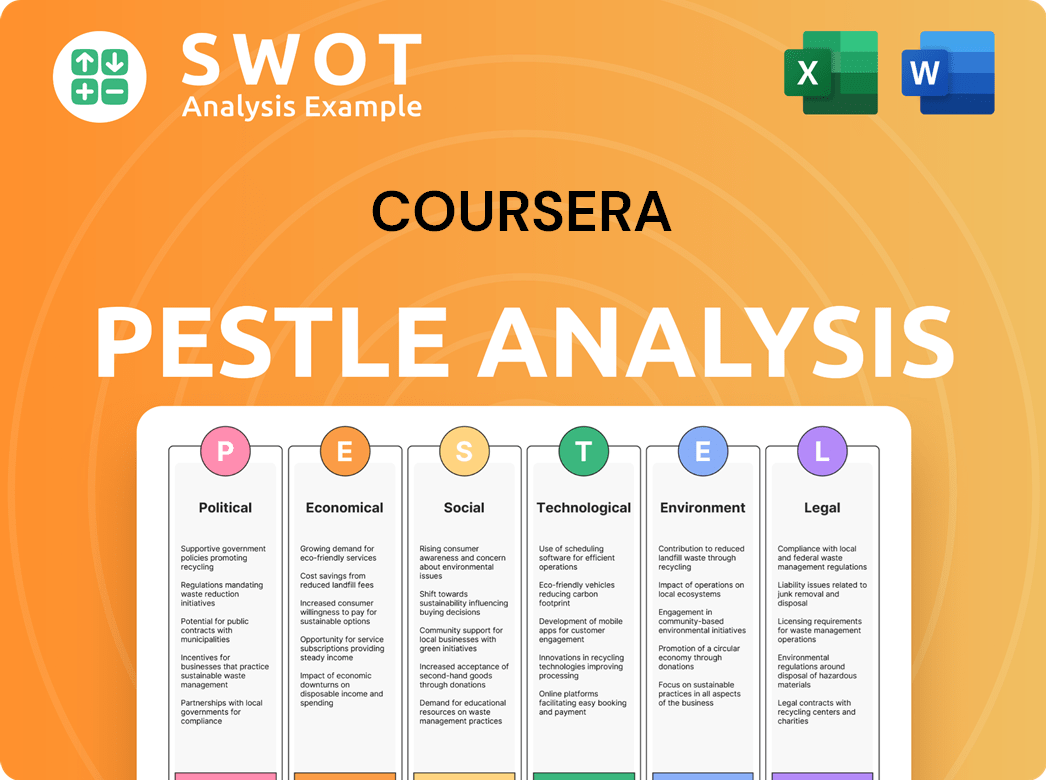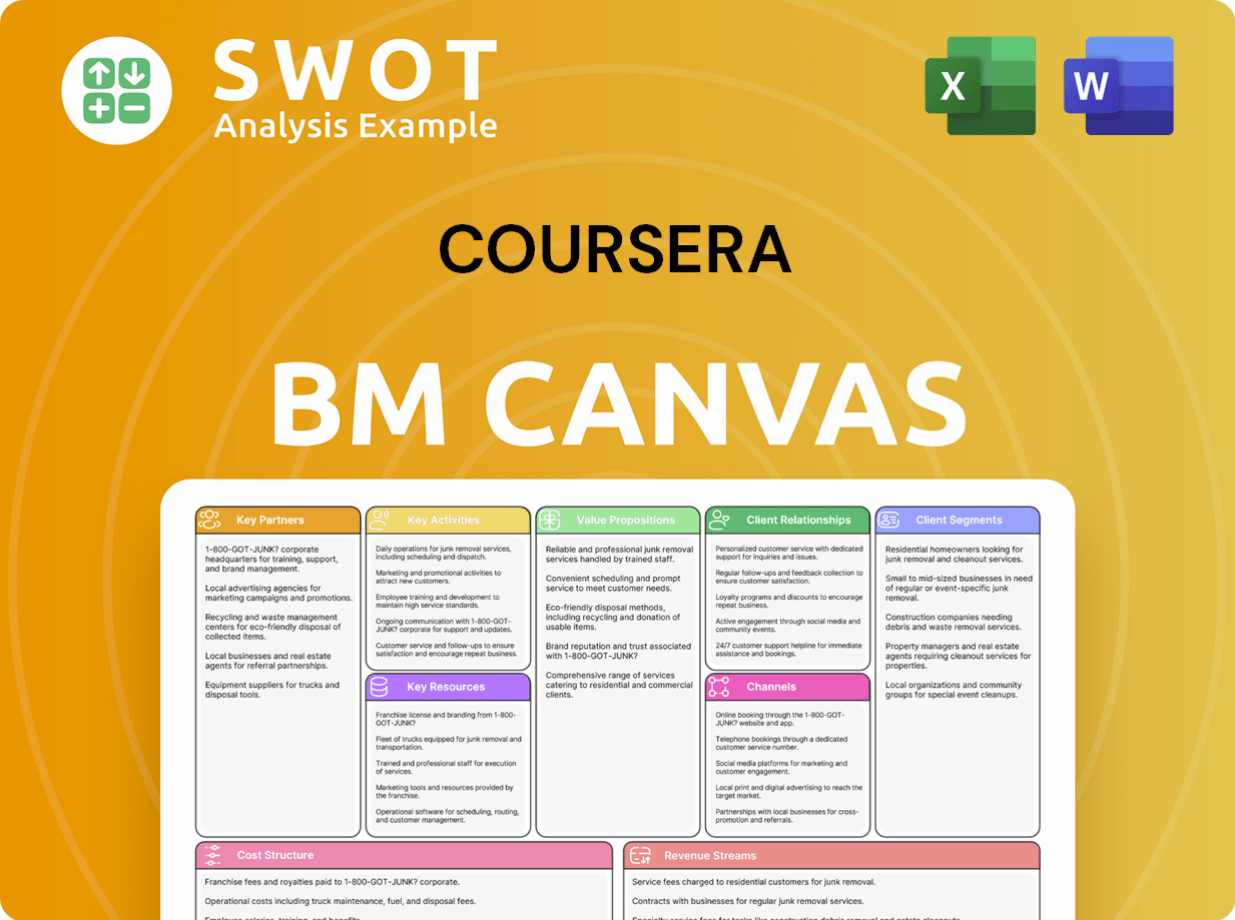Coursera Bundle
How Does Coursera Stack Up in the E-Learning Arena?
Coursera has revolutionized education, making it accessible globally. Founded in 2012, it quickly became a major player in the Coursera SWOT Analysis. This introduction explores Coursera's journey, from its inception to its current status as a publicly traded company, highlighting its impact on the EdTech industry.

As the online learning platforms market expands, understanding Coursera's competitive landscape is critical. This analysis will delve into Coursera's market positioning, its key rivals, and the strategic advantages that set it apart. We'll also conduct a thorough Coursera market analysis to understand its strengths and weaknesses compared to its competitors, including other MOOC providers.
Where Does Coursera’ Stand in the Current Market?
Coursera maintains a significant market position within the global online learning industry, particularly in higher education and professional development. As a leading platform, it offers a wide array of courses, specializations, professional certificates, and online degrees. This diverse content caters to individual learners and enterprise clients through offerings like Coursera for Business, Coursera for Government, and Coursera for Campus.
The company's core operations revolve around providing access to educational content from top universities and industry leaders. This differentiates Coursera from many other platforms, giving it a competitive edge. The platform's value proposition lies in its ability to offer high-quality, career-aligned content, making it a go-to resource for those seeking professional advancement or higher education credentials. You can learn more about the platform's origins in this Brief History of Coursera.
As of the first quarter of 2024, Coursera reported 148 million registered learners, a 15% increase year-over-year. This substantial user base underscores its strong market presence and appeal. The company's enterprise revenue also saw significant growth, with Coursera for Business enterprise customers increasing to 1,450 from 1,230 in the prior year period. These figures highlight Coursera's growing influence in the competitive landscape.
Coursera is consistently ranked among the top online learning platforms, holding a significant market share in the EdTech industry. The platform's growth is driven by increasing user engagement and enterprise partnerships. The company's focus on high-value, career-aligned content fuels its expansion.
Coursera has a strong global presence, with a diverse audience across North America, Europe, Asia, and emerging markets. Its broad reach allows it to cater to learners worldwide. The platform's international appeal is a key factor in its competitive advantage.
Coursera's primary product lines include guided projects, courses, specializations, professional certificates, and full online degrees. These diverse offerings cater to both individual learners and enterprise clients. The variety of options helps Coursera meet different learning needs.
For the full year 2023, Coursera reported total revenue of $634.7 million, a 21% increase year-over-year. The company's gross profit for the same period was $335.7 million. While the company reported a net loss of $133.4 million for the full year 2023, it has demonstrated consistent revenue growth and strategic investments in its platform and content.
Coursera’s market position is defined by its strong brand, extensive content library, and strategic partnerships. The platform's focus on career-aligned learning and accredited degrees sets it apart. This positions Coursera as a leader in the competitive landscape.
- Strong partnerships with top universities and industry leaders.
- Diverse product offerings catering to various learning needs.
- Consistent revenue growth and strategic investments.
- Growing enterprise customer base.
Coursera SWOT Analysis
- Complete SWOT Breakdown
- Fully Customizable
- Editable in Excel & Word
- Professional Formatting
- Investor-Ready Format

Who Are the Main Competitors Challenging Coursera?
The Coursera competitive landscape is complex, with various players vying for market share in the EdTech industry. Understanding Coursera's competitors is crucial for assessing its position and potential for growth. This analysis considers both direct and indirect rivals, market trends, and the impact of strategic moves within the online learning platforms space.
Coursera market analysis reveals a dynamic environment where innovation and partnerships constantly reshape the competitive dynamics. Factors such as pricing, course offerings, and target audience influence the success of each platform. The evolution of the MOOC providers landscape reflects the changing needs of learners and the increasing demand for accessible and flexible education.
Coursera's main rivals include platforms that offer similar services, as well as those that focus on specific niches or cater to different segments of the market. Competition also comes from traditional educational institutions and corporate training programs. The following sections provide an overview of the key competitors and their impact on Coursera's market position.
Direct competitors offer similar online courses and programs. They often target the same audience and compete on factors like course quality, pricing, and brand recognition. These platforms directly challenge Coursera's market share and require continuous innovation to maintain a competitive edge.
EdX, co-founded by Harvard and MIT, is a major non-profit player in the online education space. It offers university-level courses and programs, often with a strong academic focus. While EdX has a wide range of courses, it may not offer the same breadth of practical skills training as some competitors.
Udemy distinguishes itself with a vast library of user-generated content, offering a broad range of practical skills. It often has more accessible price points, challenging Coursera on volume and affordability. Udemy's strength lies in its extensive course catalog and focus on practical skills.
Udacity offers professional development programs, with a strong emphasis on 'nanodegrees' and career-focused programs in tech fields. Udacity directly competes with Coursera's professional certificate offerings. Udacity's focus on career-oriented programs makes it a strong competitor in the tech and professional development space.
Indirect competitors offer alternative ways to acquire knowledge and skills, or they target different segments of the market. These competitors may not directly offer the same courses but still compete for the attention and resources of potential learners. This category includes traditional universities, corporate training platforms, and niche e-learning providers.
Many traditional universities are expanding their online offerings, providing direct competition for Coursera. These institutions leverage their brand recognition and academic reputation to attract students. Universities like Harvard and MIT, through platforms like edX, compete directly with Coursera.
Corporate training platforms provide specialized training for employees. These platforms often focus on specific skills and industry needs, competing with Coursera's professional certificate offerings. Examples include LinkedIn Learning and internal corporate training programs.
Niche platforms offer deep expertise in specific domains, such as DataCamp for data science or Pluralsight for technology skills. These platforms attract learners seeking specialized knowledge. Their focused approach allows them to compete effectively in particular skill areas.
The Coursera competitive landscape is influenced by several market dynamics and trends. Mergers and acquisitions, technological advancements, and changing learner preferences all play a role in shaping the competitive environment. Understanding these factors is crucial for predicting the future of Coursera's competitive position.
- Mergers and Acquisitions: The 2021 acquisition of edX by 2U reshaped the competitive landscape, creating larger, more formidable entities. These consolidations can lead to increased market share and resources.
- Technological Advancements: Innovations in learning technologies, such as AI-powered tutoring and virtual reality, are changing how courses are delivered. Platforms that embrace these technologies may gain a competitive advantage.
- Changing Learner Preferences: There is a growing demand for flexible, career-focused online courses. Platforms that adapt to these preferences, offering relevant content and flexible learning options, are likely to succeed.
- Impact of the Pandemic: The COVID-19 pandemic accelerated the adoption of online learning. This has led to increased competition and a greater emphasis on the quality and accessibility of online courses.
- Financial Performance: In its 2023 annual report, Coursera reported revenue of approximately $640 million, a significant increase from previous years. This growth indicates a strong market position, but it also highlights the need for continued innovation and competitive strategies to maintain this momentum.
Coursera PESTLE Analysis
- Covers All 6 PESTLE Categories
- No Research Needed – Save Hours of Work
- Built by Experts, Trusted by Consultants
- Instant Download, Ready to Use
- 100% Editable, Fully Customizable

What Gives Coursera a Competitive Edge Over Its Rivals?
When analyzing the Coursera competitive landscape, it's crucial to understand its key strengths. The company has built a strong position in the EdTech industry by partnering with top universities and organizations globally. This strategy provides Coursera with a distinctive edge in the crowded market of online learning platforms.
Coursera's success is also driven by its extensive content library, which includes everything from free courses to full degree programs. This tiered approach helps attract a wide range of learners. Furthermore, its user-friendly interface and personalized learning paths enhance the overall user experience, which is key to retaining users and maintaining a competitive advantage.
Coursera's brand recognition and global reach contribute significantly to its competitive advantage. The company's investment in data science and AI to personalize learning experiences is another evolving advantage. Continuous innovation in content delivery, technology, and learner engagement is essential for sustaining these advantages against evolving threats.
Coursera collaborates with over 325 leading universities and industry partners, as of early 2024. These partnerships give Coursera access to high-quality, accredited content. The partnerships are crucial for maintaining a competitive edge in the MOOC providers market.
Coursera provides a wide array of offerings, including free courses, professional certificates, and online degrees. This variety caters to different learning needs and goals. This range helps Coursera attract a diverse audience and maintain its position among the top online education platforms like Coursera.
The platform offers a user-friendly interface, personalized learning paths, and robust analytics. These features enhance the learner experience and promote engagement. A positive user experience is essential for customer loyalty and retention, which is vital in the Coursera competitive landscape.
Coursera's established brand and global presence attract a large and diverse learner base. The company's international reach allows it to tap into various markets. This broad reach is a key factor in Coursera's market analysis.
Coursera invests in data science and AI to personalize learning experiences and recommend relevant content. This focus on technology helps to improve learner engagement and outcomes. For more information, you can also read about the Revenue Streams & Business Model of Coursera.
- Continuous innovation in content delivery is essential.
- Adaptation to technological advancements is key.
- Focus on learner engagement and feedback is crucial.
- Maintaining a competitive edge requires constant evolution.
Coursera Business Model Canvas
- Complete 9-Block Business Model Canvas
- Effortlessly Communicate Your Business Strategy
- Investor-Ready BMC Format
- 100% Editable and Customizable
- Clear and Structured Layout

What Industry Trends Are Reshaping Coursera’s Competitive Landscape?
The online learning industry is experiencing significant shifts, with advancements in AI and machine learning, a growing demand for skills-based education, and the rise of micro-credentials. These trends heavily influence the competitive landscape for platforms like Coursera. The market's evolution presents both challenges and opportunities, impacting strategic decisions and future growth prospects. A detailed Coursera market analysis is crucial for understanding its position.
The Coursera competitive landscape is shaped by established players and new entrants, alongside economic factors and regulatory changes. Maintaining content quality and relevance is essential. Strategic partnerships and global expansion are key for growth. Understanding the dynamics of Coursera's main rivals is vital for sustained success.
AI and machine learning are being integrated for personalized learning. Skills-based education is in demand, and micro-credentials are gaining popularity. These trends influence how online learning platforms operate and compete.
Intense competition from established and new entrants. Economic downturns could affect spending on education. Regulatory changes and the need to maintain content quality are also challenges.
Expanding globally, especially in emerging markets. Strategic partnerships with corporations and governments for workforce development. Leveraging AI for content and delivery.
Leveraging AI for content creation and delivery. Expanding degree programs. Focusing on high-demand skills to remain competitive. These strategies are vital for adapting to the evolving landscape.
The EdTech industry is experiencing significant growth. According to HolonIQ, the global EdTech market is projected to reach $404 billion by 2025. This expansion provides opportunities for platforms like Coursera to capture market share. Understanding the competitive dynamics is crucial for success. For a deeper dive, consider reading about the Growth Strategy of Coursera.
Coursera's competitive advantages include a wide variety of courses and partnerships with top universities. However, it faces challenges from competitors offering similar services. Understanding Coursera's strengths and weaknesses compared to competitors is crucial.
- Market Share: Coursera holds a significant market share among MOOC providers, but faces competition from platforms like edX and Udacity.
- Partnerships: Collaborations with universities and corporations are key to expanding reach and content offerings.
- Technology: Investing in AI and machine learning to enhance learning experiences and personalize content delivery.
- Pricing: Subscription models and pricing strategies must remain competitive to attract and retain users.
Coursera Porter's Five Forces Analysis
- Covers All 5 Competitive Forces in Detail
- Structured for Consultants, Students, and Founders
- 100% Editable in Microsoft Word & Excel
- Instant Digital Download – Use Immediately
- Compatible with Mac & PC – Fully Unlocked

Related Blogs
- What are Mission Vision & Core Values of Coursera Company?
- What is Growth Strategy and Future Prospects of Coursera Company?
- How Does Coursera Company Work?
- What is Sales and Marketing Strategy of Coursera Company?
- What is Brief History of Coursera Company?
- Who Owns Coursera Company?
- What is Customer Demographics and Target Market of Coursera Company?
Disclaimer
All information, articles, and product details provided on this website are for general informational and educational purposes only. We do not claim any ownership over, nor do we intend to infringe upon, any trademarks, copyrights, logos, brand names, or other intellectual property mentioned or depicted on this site. Such intellectual property remains the property of its respective owners, and any references here are made solely for identification or informational purposes, without implying any affiliation, endorsement, or partnership.
We make no representations or warranties, express or implied, regarding the accuracy, completeness, or suitability of any content or products presented. Nothing on this website should be construed as legal, tax, investment, financial, medical, or other professional advice. In addition, no part of this site—including articles or product references—constitutes a solicitation, recommendation, endorsement, advertisement, or offer to buy or sell any securities, franchises, or other financial instruments, particularly in jurisdictions where such activity would be unlawful.
All content is of a general nature and may not address the specific circumstances of any individual or entity. It is not a substitute for professional advice or services. Any actions you take based on the information provided here are strictly at your own risk. You accept full responsibility for any decisions or outcomes arising from your use of this website and agree to release us from any liability in connection with your use of, or reliance upon, the content or products found herein.